Often overlooked and undervalued, vacuum pumps play a crucial role in our everyday lives. They are used in numerous industrial applications, such as vacuum packaging, bottle filling and plastic molding. They are also used for a variety of scientific and medical applications, including delivering aspiration to patients in hospitals, so they can breathe when they aren’t capable. There are two different systems of vacuum pumps that deliver vacuum to the machines that require it, decentralized and centralized vacuum pump systems. There are pros and cons to choosing either a decentralized vacuum pump system or a centralized vacuum pump system for your operation. Check out the article below to help determine the choice that’s right for you.
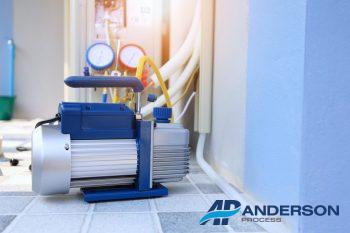
What is a Decentralized (Point of Use) Vacuum Pump?
Decentralized, or a point of use vacuum pump, is an individual vacuum pump used to produce vacuum for a specific piece of equipment or machinery it’s dedicated to. Often a new piece of equipment that requires vacuum, such as a packaging or CNC machine, will come with its own integrated vacuum pump. Decentralized vacuum pump systems are a popular, traditional option to incorporate into a design and are often easy to install.
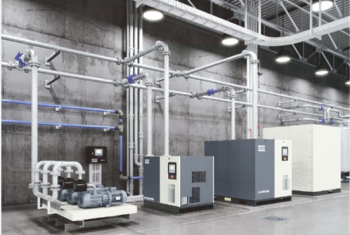
What is a Centralized Vacuum Pump System?
A centralized vacuum pump system is one or more vacuum pumps that produce vacuum for all a facility’s equipment that require vacuum. Usually, the more pieces of equipment a facility has that require vacuum, the centralized vacuum pump system will distribute vacuum conservatively and efficiently. They are often responsible for boosting productivity through swifter response time and are solid energy savers.
Photo Credit: Atlas Copco
Pros of Decentralized Vacuum Pumps and Cons of Centralized Vacuum Pump Systems
Decentralized Vacuum Pumps Don’t Need a Dedicated Room
Since decentralized vacuum pumps are each used for one purpose, a piece of equipment or machinery that utilizes its vacuum, it doesn’t need a large utility space to house them like centralized vacuum pump system’s need. All the vacuum pump modules, accessories and pipe work are usually housed in one utility room in a centralized vacuum pump system. Having the utility room space available is critical to being able to put in a centralized vacuum pump system, otherwise the operator won’t be even be able to get started. A decentralized vacuum pump network for all machines that require vacuum may be the best option for a facility if the utility space is not available.
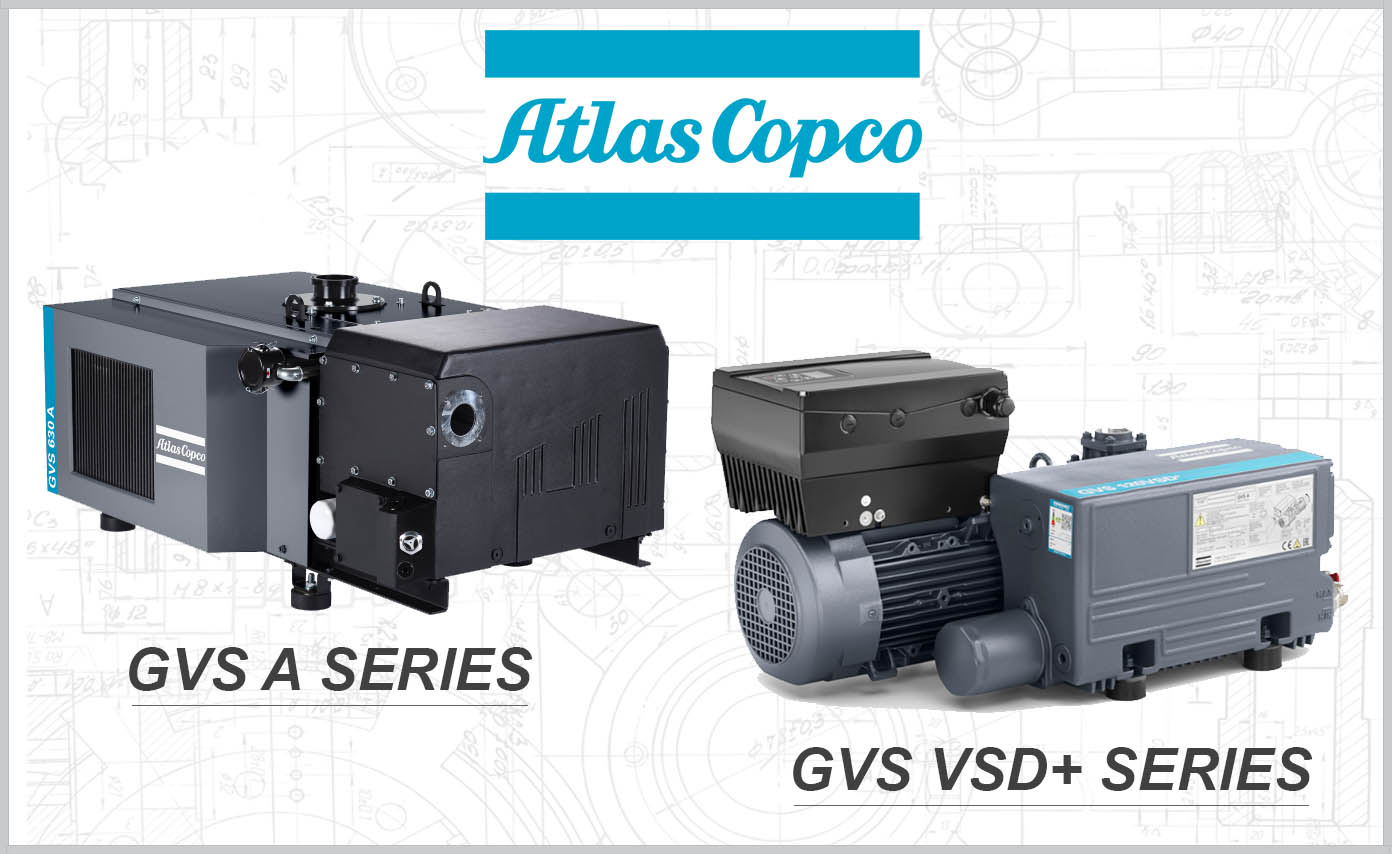
Less Complex than Centralized Vacuum Pump Systems
Using one dedicated vacuum pump for each piece of equipment or production area is much simpler to have in place than putting in a complete, centralized vacuum pump system. Centralized vacuum pump systems require piping, storage, controls, etc… and depending on the system, can be quite the complicated undertaking to have the right one in place for the intended operation.
High Cost Required to Make the Transition Over to a Centralized Vacuum Pump System
The operator needs to consider the potentially expensive cost of transitioning from a facility with decentralized vacuum pumps, already in place, to a centralized vacuum pump system. The existing decentralized pumps would become a “sunk cost” along with potentially all the production equipment already in place. New production equipment will likely be needed for a centralized system, so the operator needs to consider all the costs and decide if a centralized vacuum pump system would be worth the investment.
Decentralized Vacuum Pumps Keep the Operation Simple
Decentralized vacuum pumps are made and devoted to whatever piece of equipment needs vacuum, no matter how intricate the application is, it’s for that application’s purpose. A centralized vacuum pump system is much more complex adjusting to different vacuum levels and processing condensable gases, for potentially multiple processes that simultaneously need vacuum. Centralized pump systems can become an impractical endeavor, possibly needing filtration, separators and control valves, to function properly depending on the operation.
Decentralized Vacuum Pumps Have Strong Vacuum Power
Often designed or adjusted to the piece of equipment they are needed for, decentralized vacuum pumps maintain strong, consistent vacuum power. Centralized vacuum pump systems, however; will often pull to the lowest vacuum if different vacuum levels are needed for processes throughout the facility. The consequence being wasted energy since it will take more time and be less efficient to fulfill some processes than others. Since decentralized vacuum pump always maintains strong vacuum power it takes less time, and the process will be achieved more efficiently.
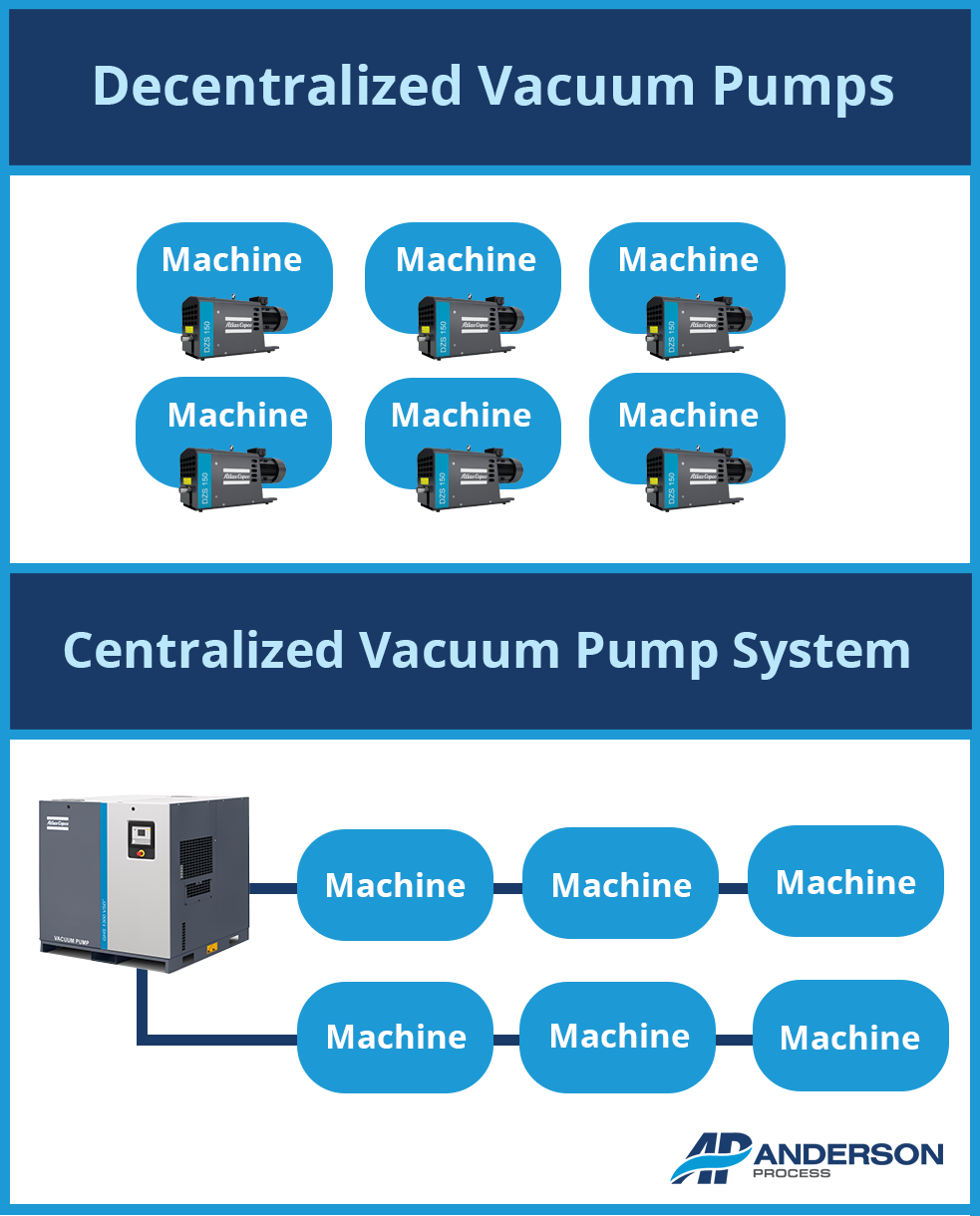
Pros of a Centralized Vacuum Pump System and Cons of Decentralized Vacuum Pumps
Energy Savings
Due to its economical way of distributing vacuum to where it’s needed, central vacuum pump systems generally need fewer vacuum pumps and therefore consume less energy than decentralized vacuum pumps that are dedicated to each individual package machine or piece of equipment. Decentralized vacuum pumps are using full power all the time, which lead to higher energy costs than if a more economical, centralized vacuum pump system were in place.
High Uptime, Less Maintenance
If one of the vacuum pumps fails in a centralized vacuum pump system, a stand-by vacuum module starts up automatically as a safeguard to keep the operation running efficiently. No downtime is required and it provides the maintenance team with ample time to fix the down unit. This is in stark contrast to a decentralized vacuum pump system, where if a unit fails that unit would likely need to be replaced. Depending on the unit, the cost of replacing it could be significant. Also, the potential downtime required to replace the failed unit can prove even more costly depending on the operation.
Save Costs on Air Conditioning and Less Noise Emission
When in use, vacuum pumps can generate a great amount of heat with the extracted air leaving the pump and the pump radiating heat itself. When decentralized vacuum pumps are installed in packaging areas, all the heat from the running pumps increases the room temperature. Production and packaging areas need to be in cool areas, so the air conditioning in the room, would need to be increased. Centralized vacuum pumps are often in a separate utility room, so they don’t affect the temperature of the production or packaging areas. This leads to additional energy cost savings. Since centralized vacuum pump systems are often contained in a separate, dedicated room, there’s less noise emission that can be heard by the staff, than if the vacuum pumps were in the production and packaging areas.
Efficient Operation and Longer Lifespan
Decentralized vacuum pumps are always operating at full power, which can be inefficient, because not all installed vacuum pumps need maximum vacuum performance all the time. Centralized vacuum pumps are controlled on a demand driven basis. Individual vacuum modules can be switched on and off to accommodate the process’ overall demand. This means the system will generate the vacuum needed at the time and utilize less energy to keep the process running efficiently. A variable speed drive is also often used to make a process more efficient by further homing in on exactly what energy would need to be expended. This can potentially result in great energy savings for the user. Being operated on a demand driven basis also expands the lifespan of vacuum pumps in a centralized system, which is the opposite of how decentralized pumps function. Decentralized pumps are used more often and therefore will have a greater chance of breaking down faster.
Even Workload Distribution
Centralized vacuum pump systems not only ensure they have as many modules as needed working, but they also function in a way where they all perform the same number of operating hours. This efficient method minimizes the workload for each vacuum pump module extending their lifespans and saving on repair costs. This even workload distribution also means a preventative maintenance plan can be enacted and easily achieved by the maintenance staff.
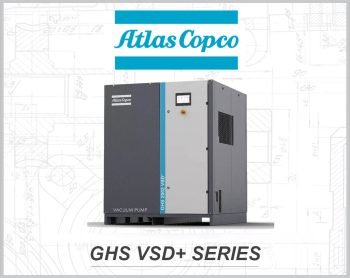
Simplified Maintenance
Maintenance for centralized vacuum pump systems is relatively simple to accomplish because it can be performed while the system is running without restrictions. A centralized vacuum pump system also has all the vacuum pumps contained within one dedicated room, making them easier for maintenance to access. The maintenance staff doesn’t have to work on individual vacuum pumps in the production or packaging area like they would with a decentralized vacuum pump system. This can be cumbersome for several factors, including inadequate space for the maintenance technician to perform the repair.
Less Risk of Contamination
Centralized vacuum pump systems are usually contained within one room, so there’s no risk of contaminating hygienic areas of the production and packaging plants. If vacuum pumps were installed in the production and packaging areas, there would be a chance of the pumps being contaminated by food residue or other bacteria. That bacteria would then have a chance of being spread to the hygienic areas and potentially being a huge problem.
Heat Recovery and Energy Savings
Utilizing an oil-water heat exchanger can save around 50-70% of a motor’s energy consumption, in a centralized vacuum pump system setup. That energy than can be recovered and reused. This is another way centralized vacuum pump systems can be more efficient and lead to more economic savings over decentralized vacuum pumps.
Anderson Process is a distributor of leading vacuum pump manufacturers, such as Atlas Copco. Atlas Copco is a provider of both decentralized (point-of-use) vacuum pumps and centralized vacuum pump systems in industries ranging from food processing, packaging, canning, extrusion and more. Contact Anderson Process today with your vacuum application requirements!
